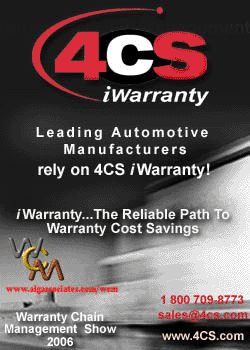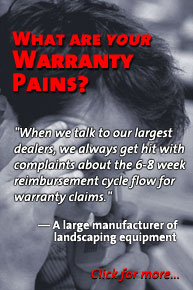June 23, 2003 |
ISSN 1550-9214 |
More Details on the | ||||||||||||||||||||||||||||||||||||||||||||||||||||||||||||||||||||||||||||||||||||||||||||||||||||||||||||||||||||||||||||||||||||||||||||||||||||||||||||||||||||||||||||||||||||||||||||||||||||||||||||||||||||||||||||||||||||||||||||||||||||||||||||||||||||||||||
| Warranty | Warranty | Percent | Percent | |
| Reserve | Claims�� | Total | Product | |
| Company | 3/31/2003 | 1Q 2003 | Sales | Sales (2) |
| General Motors Corp. | $8,863 | ($1,096) | 2.2% | 2.8% |
| Ford Motor Co. | $5,446 | ($834) | 2.0% | 2.4% |
| Hewlett-Packard Co. | $2,072 | ($581) | 3.2% | 4.0% |
| Dell Inc. (1) | $1,309 | ($217) | 2.5% | 2.7% |
| IBM Corp. | $620 | ($190) | 0.9% | 3.3% |
| General Electric Co. (3) | $1,304 | ($174) | 0.5% | 3.0% |
| Caterpillar Inc. | $705 | ($117) | 2.4% | 2.6% |
| United Technologies | $1,107 | ($113) | 1.7% | 2.3% |
| Sun Microsystems | $269 | ($106) | 3.5% | 5.2% |
| Cisco Systems | $246 | ($80.0) | 1.9% | 2.3% |
| Whirlpool Corp. | $124 | ($76.0) | 2.8% | 3.1% |
| Boeing Co. | $911 | ($69.0) | 0.6% | 0.6% |
| Lucent Technologies | $364 | ($44.0) | 2.8% | 3.5% |
| Deere & Co. | $364 | ($58.0) | 1.8% | 2.1% |
| Gateway Inc. | $55.5 | ($46.9) | 5.6% | 6.2% |
| Lexmark International | $146 | ($45.0) | 4.1% | 9.7% |
| Navistar International | $182 | ($44.0) | 2.8% | 3.0% |
| Maxtor Corp. | $267 | ($42.4) | 4.5% | 4.5% |
| Paccar Inc. | $271 | ($42.4) | 2.2% | 2.4% |
| Applied Materials Inc. | $158 | ($39.7) | 4.0% | 4.0% |
| Honeywell International | $222 | ($35.0) | 0.6% | 0.8% |
| Seagate Technology | $137 | ($33.0) | 2.0% | 2.0% |
| Maytag Corp. | $104 | ($31.4) | 2.8% | 3.1% |
| American Standard Cos. | $319 | ($27.9) | 1.4% | 1.5% |
| Brunswick Corp. | $167 | ($21.3) | 2.3% | 2.3% |
| Ingersoll-Rand Co. Ltd. | $132 | ($21.2) | 1.0% | 1.1% |
| AutoZone Inc. | $90.8 | ($20.2) | 1.8% | 1.8% |
| Fleetwood Enterprises | $61.5 | ($19.7) | 3.4% | 3.6% |
| EMC Corp. | $116 | ($19.0) | 1.4% | 1.8% |
| Dana Corp. | $130 | ($19.0) | 0.8% | 0.8% |
| Agilent Technologies | $73.0 | ($19.0) | 1.3% | 1.6% |
| Apple Computer | $68.0 | ($17.0) | 1.2% | 1.3% |
| Rockwell Collins Inc. | $138 | ($17.0) | 2.7% | 3.0% |
| ArvinMeritor Inc. | $83.0 | ($18.0) | 0.9% | 0.9% |
| Lennar Corp. | $92.8 | ($15.9) | 1.0% | 1.1% |
| Pulte Homes Inc. | $50.5 | ($15.7) | 1.0% | 1.0% |
| Champion Enterprises | $48.2 | ($15.7) | 6.4% | 7.5% |
| Mohawk Industries Inc. | $6.64 | ($15.4) | 1.4% | 1.9% |
| Avaya Inc. | $39.0 | ($15.0) | 1.4% | 2.4% |
| Terex Corp. | $59.2 | ($14.2) | 1.5% | 1.5% |
| Subtotal & Weighted Avg. | $26,921 | ($4,450) | 1.6% | 2.6% |
| All Manufacturers (750 companies) | $32,869 | ($5,703) | 1.25% | 1.92% |
Source: SEC Form 10-Q & Form 10-K
Notes:
- Derived from annual report data, estimated for the first quarter
- All percentages in this column are Warranty Week estimates
- GE reported only 2002 data; these are Warranty Week first quarter estimates
- All percentages in this column are Warranty Week estimates
Applied Materials reports its revenue geographically but provides no information on product mix. There is no mention of service or investment income, so we are forced to assume 100% of its sales are warranted. However, on June 9, Applied Materials reported even more recent warranty costs for the three months ended April 27 -- a update of the quarterly numbers initially used in the Warranty Week 500 computations. It reported spending $40.6 million on warranty in a period in which sales exceeded $1.1 billion, so that 3.7% rate represents a slight improvement on the 4.0% rate reported in the June 2 issue.
Novellus Systems reported $5.65 million in "other" income, so that amount was subtracted from total revenue. That increased their warranty cost percentage very slightly, from 5.5% to 5.6%.
American Standard Companies broke out their product sales into three segments, and noted the inclusion of service revenue in its air conditioning unit. But while it said the parts and service business was up 5%, the company quickly added that this growth rate was below plan. The company also noted that many budget-minded customers were either fixing things themselves or avoiding commitments to service contracts. Therefore, we estimate there was some service revenue but not a great deal of service revenue. We applied the 10% "tax" just to their $1.08 billion in air conditioning revenue, and removed that from the total, resulting in a slight increase in their warranty cost rate from 1.4% to 1.5%.
Ingersoll-Rand, by the way, is officially based in the Bahamas, meaning that as with Northern Telecom, its U.S. financial filings are purely voluntary. In Note 10 to its financial statement, Ingersoll-Rand breaks its revenue into five distinct product lines, but all products appear to be warranted. Further down in the management's discussion area, the company mentions both sales and service revenue for each of its business segments, although it does not provide any specific numbers. Therefore, we're applying a 10% service "tax" to its total revenue figures to arrive at a product warranty cost ratio of 1.1% -- only slightly higher than the 1.0% computed by using its total revenue number in the denominator.
AutoZone Provides Further Details
AutoZone Inc. and Pep Boys were the only pure retailers reporting any of their own product warranty activity, although Circuit City Stores Inc. and a few others reported significant extended warranty/service plan sales. AutoZone is a specialty retailer that in certain cases warrants the sale of automotive products not already covered by a manufacturer's warranty. In most cases, the manufacturer's product warranty applies, but even in some of these instances AutoZone functions as a cost-incurring middleman. Then there are the consumable parts and accessories which are warranted by nobody. So what AutoZone reports as warranty expense is really a giant mix-up of costs and overhead net of vendor recovery, where most things are warranted by somebody but not always by the retailer itself. Net sales, meanwhile, is a mix of both warranted products and consumables. Rather than trying to untangle this knot, we're going to leave the company's total revenue figures alone for now, and ask readers for advice on how to proceed.
There is news to report, however. AutoZone ended its fiscal quarters on Feb. 15 and May 10, and published its 10-Q reports on March 19 and June 11, respectively. Warranty Week used the figures filed in March for this round of chart-making, and will use the newer figures in the next round. However, it's worth noting that while the company initially reported warranty spending of $44.1 million for the six months between Aug. 31, 2000 and Feb. 15, 2003, in the latest report it provided more modular figures for the nine months between August and May, broken out into three distinct quarterly segments. Spending last fall was $23.9 million. Spending in the winter quarter was $20.2 million. And spending in the spring quarter was $22.3 million.
Absent better information, Warranty Week initially estimated that the $44.1 million spent on warranty during the six months occurred at a constant rate -- $22.05 million in the fall and $22.05 million in the winter. Now that we know it was actually a $23.9m/$20.2m split, we're modifying our figures accordingly. This drops their warranty cost from the 1.9% rate computed for the six months to 1.8% computed just for the latter three months of that same period. It also knocks them a few notches down the list of top warranty spenders, to a slot behind Brunswick and Ingersoll-Rand. By the way, in the latest period ending May 10, AutoZone's warranty cost continued to inch downward, to only 1.7% of total sales. More on that in next quarter's report.
Mohawk Industries reported a mix of product revenues coming from its own operations as well as from the acquisition of the Dal-Tile Corp. Mohawk, best known as a manufacturer of carpeting and other floor coverings, reported $276.6 million in sales by Dal-Tile, of a mix of ceramic, porcelain, and stone tiles. We're going to assume the carpets are warranted and the tiles are not, and reduce Mohawk's warranted product revenue accordingly. That changes its warranty cost ratio from 1.4% of total sales to 1.9% of just the warranted portion of sales.
Big Companies with Little Warranty Spending
Down below the top warranty spenders are a few very large companies which reported very low amounts of warranty spending. For instance, during the first quarter E.I. du Pont reported spending only $3 million on sales of nearly $7.2 billion -- an impossibly low 0.04% rate. Office furniture maker Steelcase Inc. reported spending only $2.7 million on nearly $2.6 billion in fiscal year sales -- an 0.1% rate. Eastman Kodak reported spending $12 million on quarterly sales of $2.74 billion - an 0.4% rate.
The du Pont mystery was easily solved with the help of corporate spokespersons G. Irvin Lipp and Carol Gee. Both suspected and later confirmed that only the Stainmaster carpets, the Teflon fabric protectors, and the Corian surfaces were sold with product warranties. The rest of the product line consists primarily of chemicals and raw materials that are not normally covered by product warranties.
Stainmaster comes out of du Pont Nylon, which is part of the Textiles & Interiors Group. Teflon fabric protector is part of Chemical Solutions, within the Safety & Protection Group. Corian comes out of du Pont Surfaces, which also is part of the Safety & Protection Group. Textiles & Interiors reported sales of $1.7 billion; Safety & Protection reported sales of $985 million. Using just those revenue figures, du Pont's $3 million in warranty cost rises to a still-low 0.1% of sales. We suspect the figure would be much higher if du Pont released sales figures for just Stainmaster, Teflon, and Corian, but those figures are not available.
At Steelcase, there was no mystery at all. Spokeswoman Mary Underwood said the figures are accurate as is. "Everything we sell is covered by a Steelcase product warranty," she said. "The only exceptions are items that are considered consumables," such as light bulbs and ballasts. Added Mark Baker, the company's vice president of operations, "Our relatively low warranty costs are due to a combination of the high quality and durability of Steelcase products coupled with an intense focus on all elements of our costs to ensure that all warranty claims are valid." So there you have it: best practices in a single sentence. To understand how shockingly low the company's 0.1% figure is, consider that competitor Herman Miller Inc. spent almost as much money on warranty in a single quarter as Steelcase did in an entire year. Herman Miller's warranty cost percentage was more than eight times higher as a result.
Eastman Kodak, meanwhile, dismissed the whole idea of helping Warranty Week narrow down revenue figures to just those covered by product warranties. In an email message, Kodak spokesman Anthony Sanzio cited a note in Eastman Kodak's financial filings that states "The Company has warranty obligations in connection with the sale of its equipment," and went on to state that "providing a detailed list of the equipment would take some time to pull together." He did not take any time to respond to further inquiries.
So we had to work on our own estimate. On the Kodak Web site, we found warranted digital cameras, printers, imaging systems, and film cameras along with non-warranted consumables such as paper, film, developing services, photo CD production, and software. The Medical & Dental section listed the Kodak Image Station 2000R with a one-year warranty; various models of the Microscopy Documentation System with a one-year warranty; a Professional Digital Photo Printer with a one-year warranty, and the Gel Logic Imaging System with a one-year warranty. Everything seems to get a one-year warranty, even if it's sold to businesses normally looking for three-year coverage for their computer peripherals and office equipment.
Kodak's latest Form 10-Q contains a few warranty clues as well. The note Mr. Sanzio pointed to states in its entirety,
"The Company has warranty obligations in connection with the sale
of its equipment. The original warranty period for equipment products is
generally one year. The costs incurred to provide for these warranty
obligations are estimated and recorded as an accrued liability at the
time of sale. The Company estimates its warranty cost at the point of
sale for a given product based on historical failure rates and related
costs to repair."
Then the company presents the table in which it lists $12 million in warranty cost for the first quarter, without narrowing down the products covered. Elsewhere in the 10-Q, however, Kodak provides some business segment information. Subtracting out Kodak's stated $1.8 billion in photography revenue and $21 million in other revenue leaves $921 million in medical and imaging systems revenue. However, a considerable amount of those segments' revenues also come from consumables, both X-ray and commercial film and paper. We will estimate two thirds of that medical and imaging revenue is equipment and one third is consumables. Therefore, on an estimated $614 million in equipment revenue, Kodak's true product warranty cost ratio is closer to 2.0% ($12m / $614m), a considerable jump upwards from the original warranty cost / total revenue percentage of 0.4% ($12m / $2.74b).
Pushing Extended Warranties
Notably, Kodak's extended warranty activity is more than six times larger than its basic warranty spending. According to the same section of its 10-Q, Kodak's extended warranty deferred revenue fund had a starting balance of $103 million on Dec. 31, minus subtractions (revenue recognition) of $74 million during the quarter, additions (new contracts) of $92 million, and an ending balance of $121 million on March 31, 2003. Therefore, during the first quarter, $12 million moved out of the basic warranty fund, while $74 million moved out of the extended warranty fund. That's a six-to-one ratio. Also, while Kodak put aside $12 million of its equipment sales to cover future warranty costs, it sold contracts worth $92 million for extended warranty service plans during the quarter. That's a 7.7-to-1 ratio. In other words, Kodak is driving customers to purchase extended warranties because the basic warranty coverage period is so brief.
Either way it's measured, extended warranty is much more important at Kodak than basic warranty. And it's not this way at other large companies. One could look at Ford's 1-to-2.8 ratio (the automaker recognized $299 million in extended warranty revenue to $834 million in basic warranty cost during the quarter) as an example of what would happen if Kodak were to cover its equipment with industry-norm three-year warranties. At American Standard, the ratio was 1-to-2.3 ($12 million in extended warranty recognized revenue). At Gateway, which is closer in product line to Kodak than perhaps Ford or American Standard, there was nevertheless a 1-to-2.35 ratio ($20m in extended warranty revenue recognized). In other words, while at Kodak the ratio was more than seven-to-one, at these companies it was between one-to-two and one-to-three. It's one thing to make two or three times as much on extended warranty as you spend on basic warranty. But six or seven times as much? That just seems greedy.
Then there are the companies that did not report their warranty activity. These companies can be broken into four groups:
- Did not offer product warranties and/or do not file SEC financial statements,
- Foreign companies not required to file financial statements with the SEC,
- Offered warranties, but reported only warranty reserve fund balance, and
- Offered warranties, but did not report their financials in a 10-Q or 10-K.
Companies in the first and second groups have not and will never file details of their product warranty activity with the SEC. The list of American companies that do not offer product warranties is something that would be so long that it would be best left unwritten. However, there are a fair number of foreign-based companies that through domestic subsidiaries sell warranted products on the American market. Most of the companies in group 2 are Japanese and European automotive and consumer electronics manufacturers. Many employ Warranty Week readers, who no doubt want to see their company's name in print. We have no idea how to begin estimating their quarterly U.S.-based warranty costs, so perhaps some of the readers within these companies will send us their secrets?
Foreign-based Warranty Providers
Here are the largest 50 foreign-based issuers of U.S. product warranties, in alphabetical order: ABB Ltd.; Airbus S.A.S.; Alcatel; Alstom; BMW AG; Bombardier Inc.; Bridgestone Corp.; Canon Inc.; CNH Global N.V.; DaimlerChrysler AG; Electrolux AB; Ericsson LM Telephone Co.; Fiat S.p.A.; Fujitsu Ltd.; Genmar Holdings Inc.; Hitachi Ltd.; Honda Motor Co. Ltd.; Hyundai Motor Co.; Kohler Co.; Komatsu Ltd.; LG Group; Matsushita Electric Industrial Co. Ltd.; Mitsubishi Corp.; NEC Corp.; Nintendo Co. Ltd.; Nissan Motor Co. Ltd.; Nokia Corp.; Nortel Networks; Peugeot Citroën S.A.; Philips Electronics N.V.; Pioneer Corp.; Renault S.A.; Ricoh Co. Ltd.; Robert Bosch GmbH; Rolls-Royce plc; Samsung Group; Scania AB; Schindler Holding Ltd.; Schneider Electric SA; Seiko Epson Corp.; Siemens AG; Sony Corp.; Sumitomo Corp.; Thomson Multimedia; ThyssenKrupp AG; Toshiba Corp.; Toyota Motor Corp.; Volkswagen AG; Volvo AB; and Yamaha Corp.
Thanks to the efforts of the Financial Accounting Standards Board and the reporting requirements of FASB Interpretation No. 45, all publicly-held American companies are now required to reveal never-before-seen details about their warranty activity. None of the foreign-based companies listed above are required to report, although some have filed papers with the SEC in order to sell shares in New York. For U.S.-based public companies, Warranty Week has now compiled a list of 750 companies that have filed their latest financial statements in compliance with FIN 45.
Companies in the third and fourth groups are the ones to watch. Warranty Week has a second list of some 150 non-complying companies, which we will check once again in August and November to see if they're making the required FIN 45 paragraph 14(b) disclosures. Of those 150 companies, some 63 filed either beginning or ending balances for their warranty reserve funds. By doing so, of course, they self-identified themselves as warranty-issuing companies. But if they did not disclose the inputs and outputs to the fund, they were added to the group 3 list. Another 87 were companies that never mentioned the existence of warranties even though they have a presence in a manufacturing industry in which product warranties are routinely issued, such as computers, tools & machines, electronics, automotive, or appliances. We have them listed in group 4 for now, but it is entirely possible that the reason they do not file warranty information is because they do not issue product warranties, in which they should be in group 1.
For the 150 companies which we have tentatively identified as non-complying product warranty issuers, however, the absence of information about their quarterly warranty costs limits the accuracy of an estimation of the U.S. warranty industry's size. So we threw caution to the wind, and invented estimates for each company based upon either 1) the size of their reported reserve fund, 2) the spending rate reported at a similarly-structured arch-rival, or as a last resort, 3) by applying their industry's average warranty cost as detailed in the June 2 issue to their total product revenue.
Warranty Week estimates that the 150 missing companies together spent around $652 million during the first quarter on warranty costs. Here are the top 15 estimated spenders, which together accounted for $541 million of that estimated total:
Warranty Spending: Who's Missing?
First Quarter 2003
| Likely | |
| Warranty | |
| Company | Spending |
| Flextronics International | $50 |
| Emerson Electric | $50 |
| Lockheed Martin Corp. | $50 |
| Northrop Grumman Corp. | $47 |
| Motorola Inc. | $45 |
| Solectron Corp. | $43 |
| Textron Inc. | $38 |
| Sanmina-SCI Corp. | $37 |
| Parker Hannifin Corp. | $28 |
| Federal-Mogul Corp. | $24 |
| Black & Decker | $21 |
| Eaton Corp. | $21 |
| American Axle & Mfg. | $15 |
| Masco Corp. | $10 |
| Other Non-Reporters | $111 |
| Total Non-Reporters (150 companies) | $590 |
The top five were contacted, soliciting possible reasons for their lack of FASB FIN 45 compliance to date. It's no shock to announce that all five declined to comment. No doubt, they won't enjoy seeing their names in the paper either. One might even suggest that they wish FASB and its warranty disclosure rules would just go away and leave them alone. However, it is hoped that once they understand the process, they will join their competitors in filing details about their product warranty costs. As Mr. Daniel wrote, "quality-conscious customers would then have a better chance of identifying those companies that pro-actively manage their products and objectively report their performance."
 As mentioned, the number of warranty-reporting companies now extends to 750. Their total warranty spending for the first quarter (both in cash and in kind) now totals $5.7 billion. The biggest spenders had average warranty costs of 1.5% of total revenue and 2.7% of just warranted product revenue. All manufacturers together averaged 1.2% and 1.9%, respectively. Together, their warranty reserve funds at the end of the quarter topped $32.8 billion (these estimates now includes more than $1.3 billion set aside for warranty by GE, hence the upwards revisions).
As mentioned, the number of warranty-reporting companies now extends to 750. Their total warranty spending for the first quarter (both in cash and in kind) now totals $5.7 billion. The biggest spenders had average warranty costs of 1.5% of total revenue and 2.7% of just warranted product revenue. All manufacturers together averaged 1.2% and 1.9%, respectively. Together, their warranty reserve funds at the end of the quarter topped $32.8 billion (these estimates now includes more than $1.3 billion set aside for warranty by GE, hence the upwards revisions).
If one were brave enough to add in these back-of-the-envelope first quarter estimates for non-reporting companies, and then if one multiplied the new quarterly estimate by four to get an annual figure, one could surmise that at current rates U.S. manufacturers will spend around $25 billion on product warranty cost this year. This estimate would rise even higher if figures were invented for all the foreign manufacturers that sell warranted products in the U.S., but which don't have to report those figures to the SEC in a 10-Q. Could warranty be a $26 or $27 billion industry? Probably. There are several foreign-based warranty issuers with U.S. programs that are likely the size of Ford, Dell, Caterpillar, Boeing, or Whirlpool. Might it be even $30 billion in size? Probably not. But don't ever let anyone ever again tell you that warranty is a small industry.
| Back to Part Three | Go to Part Five |

|
This Week’s Warranty Week Headlines | ||
|
NHTSA issues new performance standards for passenger car and light truck tires, but they're not effective until June 2007. Press Release, June 23, 2003 | ||
|
Circuit City Stores Inc. reports quarterly loss for period ending May 31, says extended warranty sales dropped to 3.7% of total sales from 4.2% the year before. This Week in Consumer Electronics, June 23, 2003 | ||
|
Used auto extended service plan issuer Warranty Administration Services alters contract terms in response to complaints lodged by UK's Office of Fair Trading. BBC News, 23 June, 2003 | ||
|
NHTSA postpones TREAD Act early warning report deadlines, also plans to revise reporting templates. NHTSA Online Notice, June 18, 2003 | ||
|
Oracle raises PeopleSoft hostile takeover bid to $19.50 cash per share; State of Connecticut files suit to block the deal. MSNBC, June 18, 2003 | ||
More Warranty Headlines below | ||

|
|
|

|
Warranty Headlines (cont’d) | ||
|
National Warranty Insurance Company RRG (NWIC) files for bankruptcy protection in a Cayman Islands court; dispute with Pacific Fiduciary Investment Corp. over claims on high-mileage "Smart Choice" auto policies sold by the Delta Group's SC&E Administrative Services (owned by Yamagata Warranty) is what pushed them into insolvency. Lincoln Journal Star, June 7, 2003 | ||
|
Oracle makes an offer to acquire PeopleSoft for $16 per share in cash. Press Release, June 6, 2003 | ||
|
PeopleSoft announces plan to acquire J.D. Edwards in $1.7B stock swap. Press Release, June 3, 2003 | ||
|
Adobe Systems expands help line; Expert Support now covers "how to" questions not covered by basic warranty support. CNET News.com, June 2, 2003 | ||
|
Attorney Glen Darbyshire, of Inglesby, Falligant, Horne, Courington & Chisholm, presents an overview of the TREAD Act from the perspective of trailer manufacturers and their suppliers. Trailer/Body Builders, June 1, 2003 | ||
More Warranty Headlines below | ||

|
Related Articles From Warranty Week |


 Hewlett-Packard Co. warranty manager Bill Alesbury wrote in to suggest that warranty as a percent of total revenue is somewhat misleading. "Its usefulness is its convenience," he wrote, "since it is based on almost-readily-available data. Anyone can calculate it and immediately satisfy the need to understand one�s competitive position, at least ostensibly. But "benchmarking" at this level is loaded with hidden issues such as:
Hewlett-Packard Co. warranty manager Bill Alesbury wrote in to suggest that warranty as a percent of total revenue is somewhat misleading. "Its usefulness is its convenience," he wrote, "since it is based on almost-readily-available data. Anyone can calculate it and immediately satisfy the need to understand one�s competitive position, at least ostensibly. But "benchmarking" at this level is loaded with hidden issues such as: Several of the computer manufacturers made this type of comparison somewhat difficult, because either they reported just a geographic breakdown, or they mixed apples and oranges in a category identified only as "products." Fortunately,
Several of the computer manufacturers made this type of comparison somewhat difficult, because either they reported just a geographic breakdown, or they mixed apples and oranges in a category identified only as "products." Fortunately,  It's been only three weeks since the debut of the Warranty Week 500, but already some companies are obsoleting their most current warranty cost figures by filing new financial reports with the Securities and Exchange Commission. We'll discuss a few of these cases below, but for the most part the cutoff for this round of numbers was May 31. We'll do this roundup again in September for all the reports filed between June 1 and Aug. 31, and again near the end of the year for reports filed between Sept. 1 and Nov. 30. It's also likely that more companies missed during this go-round will be added as readers continue sending in their lists of competitors.
It's been only three weeks since the debut of the Warranty Week 500, but already some companies are obsoleting their most current warranty cost figures by filing new financial reports with the Securities and Exchange Commission. We'll discuss a few of these cases below, but for the most part the cutoff for this round of numbers was May 31. We'll do this roundup again in September for all the reports filed between June 1 and Aug. 31, and again near the end of the year for reports filed between Sept. 1 and Nov. 30. It's also likely that more companies missed during this go-round will be added as readers continue sending in their lists of competitors. Elsewhere, manufacturers such as
Elsewhere, manufacturers such as  Also, GE said that almost all of that warranty spending came out of its power systems division. So rather than computing its warranty cost ratio at 0.5% based on $131.7 billion in total sales, we're computing it at 3.0% from just that single division's $22.9 billion in sales.
Also, GE said that almost all of that warranty spending came out of its power systems division. So rather than computing its warranty cost ratio at 0.5% based on $131.7 billion in total sales, we're computing it at 3.0% from just that single division's $22.9 billion in sales.